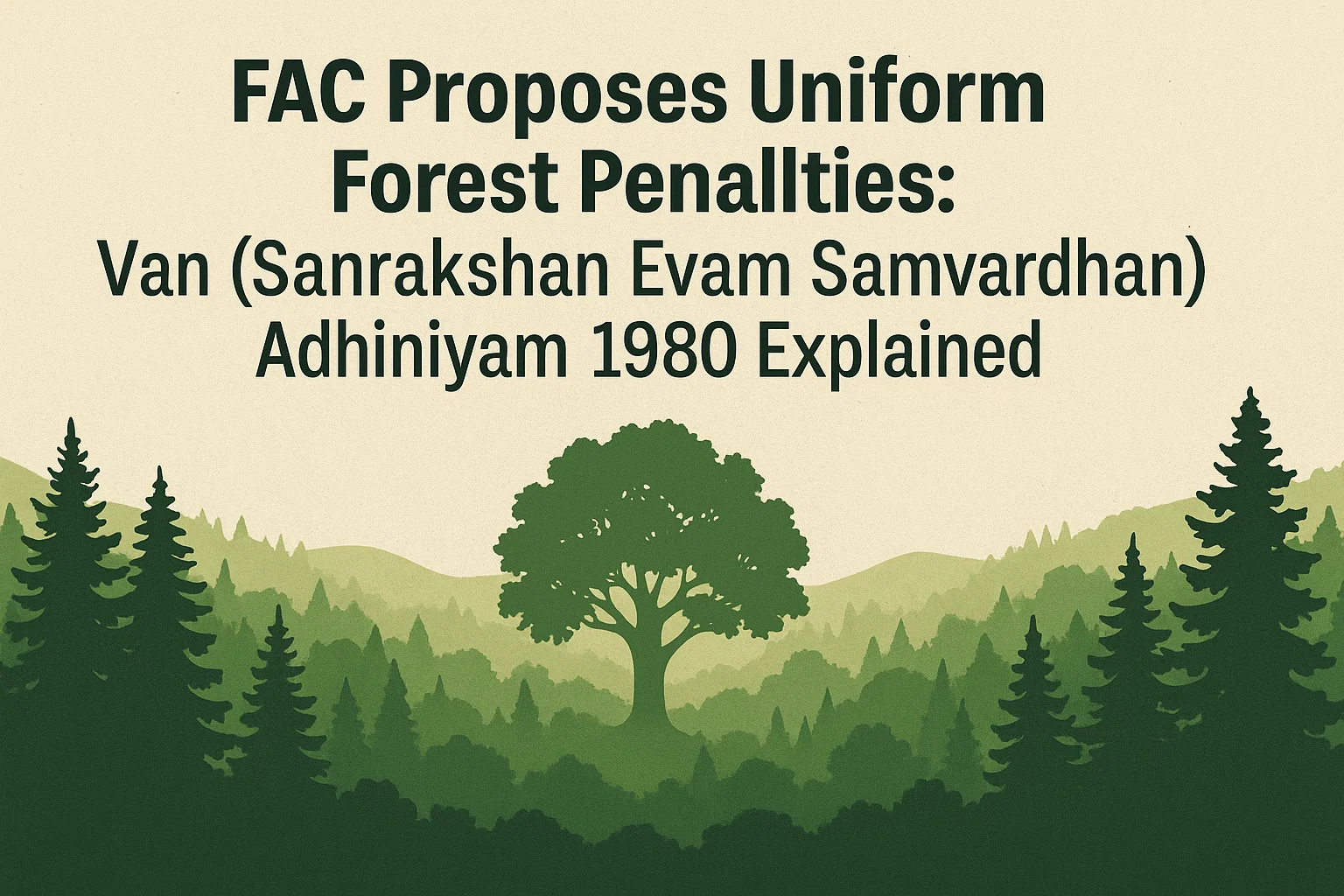FAC Proposes Uniform Forest Penalties: Van (Sanrakshan Evam Samvardhan) Adhiniyam 1980 Explained
Learn about the Forest Advisory Committee’s proposal for uniform forest penalties under the Van (Sanrakshan Evam Samvardhan) Adhiniyam, 1980. Understand the FAC’s role, key functions, 2023 rule changes, environmental concerns, and measures to balance development with ecological conservation — essential for UPSC Environment and Polity preparation.
FAC Proposes Uniform Forest Penalties: Key Provisions and Environmental Implications
The Union Environment Ministry’s Forest Advisory Committee (FAC) has recommended rationalisation and uniformity in penal provisions under the Van (Sanrakshan Evam Samvardhan) Adhiniyam, 1980 (formerly Forest Conservation Act, 1980).
What is the Forest Advisory Committee?
- The Forest Advisory Committee (FAC) is a statutory expert body constituted under Section 3 of the Forest (Conservation) Act, 1980 (now Van [Sanrakshan Evam Samvardhan] Adhiniyam, 1980).
- It functions under the Ministry of Environment, Forest and Climate Change (MoEFCC).
- Composition: Chaired by the Director General of Forests (DGF). Includes officials from MoEFCC, forest experts, and representatives from various states.
What are the major functions associated with it?
- Scrutinises proposals for diversion, de-reservation, or leasing of forest land for non-forestry activities. Advises the Central Government on whether such diversion is permissible under the Act.
- Recommends mitigation measures, including compensatory afforestation (CA) and payment of Net Present Value (NPV) of diverted forests.
- Examines violations of the Act and recommends penal actions (e.g., penal CA, penal NPV).
- Ensures uniformity in application of penal provisions and conservation norms across states. Reviews compliance and functioning of State and regional forest authorities.
What is Van (Sanrakshan Evam Samvardhan) Adhiniyam, 1980? Why was it enacted?
The Van (Sanrakshan Evam Samvardhan) Adhiniyam, 1980, is the renamed Forest (Conservation) Act, 1980, after amendments in 2023.
- Purpose: To prevent deforestation and regulate the diversion of forest land for non-forest purposes without prior central approval.
- Why enacted: To ensure that forest lands, which are vital for ecological stability, biodiversity, and environmental services, are protected from unregulated commercial or infrastructure projects.
- Violations include: de-reservation, non-forest use, lease, or clear felling of forest land without government permission.
What are the Van Adhiniyam Rules, 2023?
- Updated rules under the 1980 Act that define penalties and compensatory measures for violations.
- Introduced penal Net Present Value (NPV), which is a monetary charge up to five times the value of the diverted forest area. here
- Include guidelines for penal compensatory afforestation in addition to the NPV, aimed at restoring ecological balance.
- Establish Integrated Regional Offices (IROs) for faster approval and monitoring.
What are the significant concerns associated with the Van Adhiniyam Rules, 2023?
- Broad exemptions: Excludes certain infrastructure projects (e.g., defence, border roads) from mandatory clearance, possibly weakening protection for ecologically sensitive areas.
- Ambiguity in definition of ‘forest’: Excludes some unrecorded forest areas under the ‘dictionary definition’, risking legal forest cover reduction.
- Discretionary powers: Significant power rests with the Centre, limiting state and local (Gram Sabha) participation.
- Impact on forest-dependent communities: Potential dilution of Forest Rights Act (FRA), 2006, and tribal consent processes.
- Implementation gaps: Variation in enforcement and lack of uniform penal framework led to inconsistent penalties — issue now addressed by FAC’s latest recommendation.
What can be done to ensure a balance of growth and ecological balance?
- Strengthen participatory governance: Mandatory consultation with Gram Sabhas, local panchayats, and forest dwellers before approvals.
- Transparent EIA and public disclosure: Publish EIA reports, FAC recommendations, and mitigation plans online for public scrutiny.
- Scientific and region-specific CA planning: Match compensatory afforestation to local ecosystem type, not just tree count or area.
- Integrate FRA and biodiversity laws: Synchronise with Forest Rights Act (2006) and Biological Diversity Act (2002).
- Independent monitoring & penal uniformity: Third-party audits for compliance; rationalise penal NPV and penal CA to ensure proportionality.
- Promote sustainable development pathways: Encourage eco-restoration, green infrastructure, and low-impact tourism instead of indiscriminate diversion.
- Long-term valuation of ecosystem services: Integrate natural capital accounting into project cost–benefit analysis.
Subscribe to our Youtube Channel for more Valuable Content – TheStudyias
Download the App to Subscribe to our Courses – Thestudyias
The Source’s Authority and Ownership of the Article is Claimed By THE STUDY IAS BY MANIKANT SINGH



